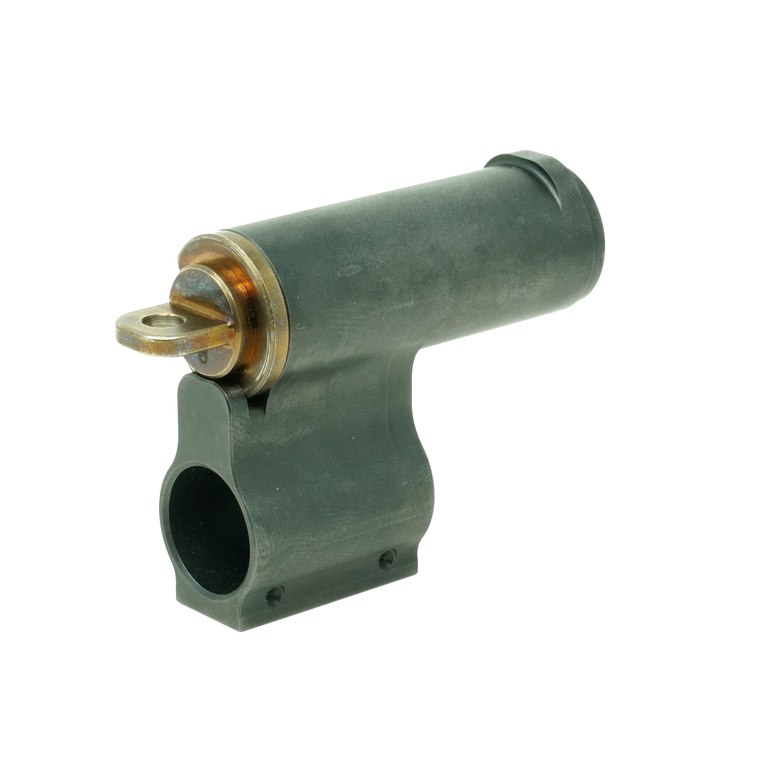
WE ARE CURRENTLY ASSEMBLING GASBLOCKS AND WILL BE SHIPPING BACKORDERS AND NEW ORDERS STARTING MONDAY JUNE 30TH
PLEASE SEE THE GAS VALVE/CUP SPECIFIC PAGE HERE TO ANSWER GAS VALVE QUESTIONS!
Our billet adjustable gas block is specifically designed to be compatible with our MERC handguard, but will also work just fine on classic AKMs and AK-74s. Rather than using the usual set screw, this design utilizes a gas cup with multiple aperture sizes around the rim. This cup, combined with a detent, allows the user to select between discrete sizes. The design has no screws; nothing to come loose under high temperature conditions! The gas cup design borrows heavily from historically rugged designs from HK, SIG, AK-12, and FN. As all gas blocks accumulate carbon, we've designed in a removal feature so that the cup can be removed from the front by rotating to the section of cutout flange and pulling towards the muzzle end of the barrel.
**PATENT PENDING**
SPECIFICATIONS:
- 4140 ALLOY STEEL HEAT TREATED AND NITRIDED BODY
- 17-4 STAINLESS STEEL HEAT TREATED APERTURE CUP
- DRILL LOCATION IN 45 DEGREE (AKM) LOCATION
- INCONEL 1100F RATED DETENT SPRING
- 0.591" NOMINAL INSIDE DIAMETER OF BARREL BORE (WE LIST THE PRECISE INSIDE DIAMETER OF YOUR INDIVIDUAL GAS BLOCK ON THE INSTRUCTIONS THAT COME WITH THE PART)
USER MANUAL DOWNLOAD: AGB USER MANUAL
The easiest way to reduce excessive interference on the barrel bore diameter is with an adjustable lap. You can get a good one at Mcmaster-Carr. The mcmaster part number for the lap is 4548A23, and some good diamond compound is mcmaster part number 4428A19 . The diamond paste is a bit spendy—more economical aluminum oxide or silicon carbide compound works as well. You only need a tiny amount of diamond paste—no more than the volume of a pea (though you’ll need to add more over time). To size the bore up, rub compound then drip oil on the lap, chuck it in a drill, and spin at a moderate RPM while stroking the lap in and out of the barrel bore, evenly across the length of the lap. You’re likely to not have any resistance at first. Tighten the screw on the end of the lap by about 1/16 of a full turn. Repeat this process until you feel mild to moderate resistance to holding the gas block still while the drill is spinning. Ideally you want to cradle the gas block so that it aligns to the lap, and the only thing your hand on the gas block is doing is resisting the rotation of the block. Once you’ve run the lap for 30 seconds or so with moderate resistance, the part should be getting a bit warm. Pull a rag through the bore, and try banging it on the barrel again. Repeat the above till you feel the block smoothly hopping up the barrel with every hammer blow. The barrel should be in a vise—never put hammering or pressing load on the receiver.
Reviews
-
What's the story with the name on the return label?
Fantastic product! Great design. Amazing, over the top, Packing Thanks
-
Adjustable gas block
Why did I give this part four stars and not five? Well, I haven't fired the rifle yet! Seriously, just today I got my barrel pressed in and headspaced perfectly, on the first try! Soon I'll be fitting the gas block to the barrel and hopfully be able to take it out and shoot it and see how it does. When I do, I'll do another review about how that went. But so far, this thing is awesome! Really well made, and it even comes in a neat little tin you can use for just about anything. What a great freebee! I can't wait to get the OD rail for this thing!
-
Best gas regulator on the market.
Simple, well built, easy to adjust. Five positions including no gas at all. Narrow enough to fit in extended handguards as well.
-
Adjustable Gas block
This is the best adjustable gas block I’ve used. Super easy to adjust. High quality
-
Best addition to my Kalash
Amazing quality, a must have for your kalsh especially if you run a suppressor!















